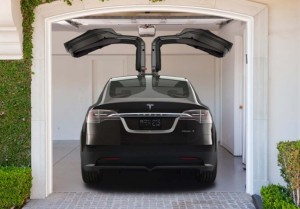Hours after confirming it had signed a formal agreement with Japanese electronics giant Panasonic to build its new, $5 billion “Gigafactory,” battery-electric automaker Tesla Motors revealed it earned a modest $16 million during the second quarter of the year, or 11 cents a share.
That figure was nonetheless well ahead of the Wall Street consensus which had anticipated earnings of just 4 cents a share. The start-up automaker also noted that it had boosted production for the April-june period to 8,763 of its Model S sedans, with sales reaching 7,759. That drove a 55% jump in revenues, to $858 million.
Tesla’s profit is a matter of perspective. It was in the black – but only by using non-traditional accounting methods. According to the generally accepted “GAAP” methods, however, the maker lost $62 million, or 50 cents a share.
The earnings announcement came just a week before Tesla said it will launch production of its second product line, the Model X battery SUV, CEO Musk confidently declaring during a conference call that “We will not have a demand issue” for the new offering.
(For the latest on the Tesla Gigafactory, Click Here.)
The addition of the Model X is seen as critical for Tesla as it pushes to expand behind a narrow niche with the Models S, a large luxury sedan that carries a price tag that can push upwards of $110,000 fully loaded. The maker recently announced plans to go even further into the mainstream when it launches its midsize Model 3 battery vehicle in 2017, but until then, the SUV will have to keep demand growing.
(Click Here for more on Tesla’s plans for the Model 3.)
Tesla said it expects to see only a modest increase in sales during the third quarter, to around 7,800, because it had to shut down its plant in Fremont, California in recent weeks to add tooling to handle the new SUV. It would otherwise have been able to deliver about 9,000 makers, it said.
Nonetheless, it will have to significantly ramp up production during the final three months of the year to meet a sales goal of 35,000 vehicles for all of 2014.
But the pace at the factory is increasing rapidly, Musk noting that, “We’re going to try to move to several hundred units a week within 3 months of production,” once the Model X launches. That would be about twice as fast as the ramp-up of the Model S.
It is pushing for even more growth in 2015, and with two models in its line-up, the maker said in a statement, “Provided that we execute well and there are no serious macroeconomic shocks, Tesla’s annualized delivery rate should exceed 100,000 units by the end of next year.”
There remain some skeptics who question how much broader the market for battery-electric vehicles will grow, especially without the addition of an appealing and affordable mainstream product like the Model S.
On the positive side, Tesla has been expanding into both Europe and, more recently, China where the Beijing government is directly supporting the growth of the electric vehicle market in a desperate bid to deal with the country’s massive air quality problems.
But Tesla made it clear that the Model 3 will be critical over the longer-term, warning shareholders of the potential “revenue(s) that could be lost if the launch of Model 3 were affected by any delays at our primary Gigafactory site.”
In an announcement earlier on Thursday, Tesla said it would be responsible for setting up and operating the planned battery production site, with Panasonic paying for and running the actual manufacturing lines. The Gigafactory is expected to employ over 6,500 workers and become the largest lithium-ion plant in the world. Tesla and Panasonic also hope to sell some of the batteries produced there to other automakers.
(Copenhagen Wheel makes any bicycle an EV. For more, Click Here.)
The batteries produced at the factory are expected to be lighter, more powerful and less expensive than existing lithium-ion technology, Musk noting during his call, ““There are improvements to chemistry, as well as the geometry of the cells.”
During his call, Musk pointed to the company’s strong record for quality and customer satisfaction, saying it is his goal to set industry benchmarks on both counts. The Model S has been well reviewed, among other things being hailed by influential Consumer Reports as the best vehicle the magazine ever tested.
“We’re going to be at it hardcore until our car is ten times better than any other car on the road,” Musk said.


Musk is certainly relying on a lot of “ifs” for his projections to become reality.
Like P.T. Barnum said, there is a sucker born every minute. They can be identified by the car they were chumped into buying.
So far tesla has lost 100 million this year and their are still 2 quarter s left.
Good going elon. Take some math classes and come back once you become an American citizen.